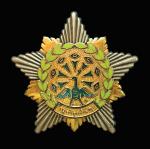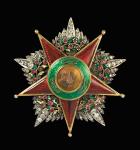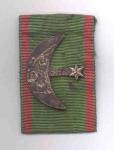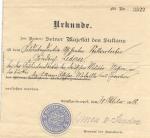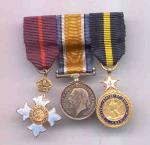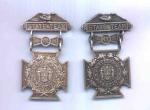
JBFloyd
Moderator-
Posts
1,242 -
Joined
-
Last visited
-
Days Won
1
Content Type
Profiles
Forums
Blogs
Gallery
Events
Store
Everything posted by JBFloyd
-
-
See later posting below.
-
I'll try to get a photo of a third class badge as well.
-
A "happy snap" of a spectacular first class star of the Turkish Order of Charity, a women's order. Missing a couple of gems, but not something you see every day.
-
-
Not much out there on-line about Manchukuo awards. The hard-copy reference is still Jim Peterson's OMSA monograph "Orders and Medals of Japan and Associated States", third edition. This edition was extensively revide to include color photographs. In the meantime, here's an Order of the Pillars of State, fourth class, which amply exhibits the quality of design and workmanship of Manchukuo awards.
-
Mongolia What is this ..? Part two
JBFloyd replied to ANDY BUTKUS's topic in People's Republic Mongolia
The main Mongolian reference refers to it as "Meda 'We Won'", so Victory Medal for WWII. -
The short answer is that they are items currently being churned out in China for the tourist trade.
-
MBE case Help please!
JBFloyd replied to notned's topic in Great Britain: Orders, Gallantry, Campaign Medals
The case is for a bow-mounted MBE (i.e., an award to a woman). The pin on the back of the bow fits into the depression. -
Prince Philip's Medals
JBFloyd replied to a topic in Great Britain: Orders, Gallantry, Campaign Medals
In addition to marrying well, Philip actually had a creditable naval career. He was aboard HMS Ramillies as a midshipman at the outbreak of the war. In 1941, he was aboard HMS Valiant at the battle of Matapan (21 March 41), where he was MID'd and received the Greek War Cross (other family conections helped probably, since he was Prince Philip of Greece at the time). Later, he was aboard HMS Whelp, a destroyer in the Pacific and was present in Tokyo Bay for the surrender. He married then-Princess Elizabeth in late 1947, so that didn't do much for him during the war. However, being the nephew of Lord Mountbatten might have opened a few doors. He took the name Mountbatten when he renounced his Greek citizenship. Like Rick Research, Philip is related to just about everyone in Europe. -
This came out of a collection heavy with Imperial German and Austrian material. Unfortunately, the collector had no idea what it was (and neither do I). It's a white metal piece, unmarked, with a straight horizontal pin. The standing figures are wearing a fez and look European. The crescent and star lead toward Turkey, but... Any ideas?
-
North Dakota National Guard 6 Year Faithful Service
JBFloyd replied to Hauptmann's topic in United States of America
This design predates the current state Long Service Medal, which was authorizied in 1905. As with so many state awards, however, there is little documentary history for these. Perhaps the Adjutant General's reports for the 1880-90s would turn up references to the establishment of this badge. If nothing else, it represents the day when medals were made by real manufacturers, and not some clip-art jocky in Lower Slobovia. -
Republic of Cuba Medalla "Por la Defensa de Cuito Cuanavale"
JBFloyd replied to a topic in Republic of Cuba
Rick, Cuito Cuanavale was one of those actions in Angola where the Cubans claimed a smashing victory and retreated from the front. If you read the Cuban claims of the time, they apparently killed most of the South African Defense Force and destroyed all of their equipment and aircraft. However, shortly afterward, the Cuban were looking for a quiet way out as the Russians figured out what a morass Angola was. Check this web site for a fairly good synopsis: http://www.rhodesia.nl/cuito.htm A Google search on "Cuito Cunavale" will bring up some rather bizarre articles from the Cuban side as well as the South Africans. -
Many WACs got married after the war and changed their names, driving researchers crazy. The Women In Military Service to America web site (http://www.womensmemorial.org/) might also offer some ways to track down Ms Kroll. Kroll (born in 1919) enlisted from New Haven, Connecticut on 21 Oct 1943 as a WAC private. She apparently had some industrial experience (lathe or machine operator before enlisting. Her Army Service Number was A-130249.
-
My functional illiteracy strikes again as I once could read these documents without difficulty. On this one, I can get the part about the Military Mission in Turkey and that it's for the Silver "Iftikar", but the name (beyond "Lederer") and rank are beyond my rusty skills. Can someone break the code for me.
-
RN group with US award
JBFloyd replied to JBFloyd's topic in Great Britain: Orders, Gallantry, Campaign Medals
Thanks, Rick. I was able to pull some of this out of a Debrett's when the group first appeared. Now I need to find him in the various sources on the North Sea Mine Barrage and see what his connection to the US Navy really was. -
RN group with US award
JBFloyd replied to JBFloyd's topic in Great Britain: Orders, Gallantry, Campaign Medals
-
Being a collector of Anglo-American groups, I was most happy to have this one arrive in the mail this morning from the most recent Baldwin's sale. It's to Captain H.F.J. Rowley, RN, who was Transport Officer and Senior Naval Officer at Inverness in World War I. He's one of 71 Royal Navy recipients of the US Navy Distinguished Service Medal in WWI. Since Inverness was the base for the US Navy's minesweeping operations in the NOrth Sea, his DSM almost certainly relates to that connection. I haven't unpacked his CBE yet, but it's represented on his miniature group.
-
USV 1898 Marksmans' badge (17 years)
JBFloyd replied to Ulsterman's topic in United States of America
Here are a couple of State Team badges, which illustrate a couple of variations. The early badges have "NY" in the center of the year bar; later badges have either "Mil" or "Civ" on the year bar. -
USV 1898 Marksmans' badge (17 years)
JBFloyd replied to Ulsterman's topic in United States of America
New York Small Arms Practice Badge (Type 3, for those who collect such things). This design came in about 1899 and was awarded through 1913. There were bars for "Sharpshooter", "Expert", "18 - USV - 98" and "18 - USN - 98", plus year bars for the three qualification levels. The "18 - USV - 98" bar was for those with Army service in the Spanish American War. The "18 - USN - 98" bar was for Navy service, and is not often seen. There are other variations in the top bar: "Champion Marksman" in silver, for enlisted men who had the highest scores in annual qualifications. ""State Team" in silver (as is the whole badge), awarded with bars for the years the man qualified for the state team. While antique dealers usually get excited about the Tiffany mark on these badges, Tiffany was the most prolific maker. Badges by other makers are far scarcer. -
Vets find they can't buy recognition Price of Nobel glory tops $100, but it's not for U.S. Korean War GIs By E.A. Torriero, Chicago Tribune, May 28, 2006 Thinking they had received long-awaited recognition, more than 100 Korean War veterans in the U.S. hoped to stand prouder at Memorial Day parades this year. They plunked down $115 or more in recent weeks for what was billed as "unique proof" that Korean-era soldiers were part of the Nobel Peace Prize of 1988 awarded to United Nations peacekeepers. For that, they received a certificate from a Danish marketing firm emblazoned with the UN logo, bearing the signature of a Norwegian defense minister, certifying them as members of the UN peacekeeping forces. It came with a simple white copy of the Nobel diploma. And it was packaged with a gold gilt "International Peace Prize Medal 1988" hanging from a light blue ribbon decked with the colors of the Norwegian flag and the words "The Nobel Peace Prize 1988." But as the Tribune investigated the honors, Nobel Peace Prize officials said last week that Korean War veterans are not part of the 1988 prize. It appears many who bought the medals may have been deceived. At best, they are victims of transcontinental confusion created when several officials with a Norwegian UN veterans association took it upon themselves to recognize the long-ignored Korean War veterans. The truth seems to have been lost in translation. A Norwegian veterans group has the rights to produce the medal. It appears false information has been published in its advertising campaign, although officials of the group insist there was no intent to defraud and no wrongdoing. As a result of the Tribune's findings, several inquiries are now under way by Nobel officials, the UN and the Norwegian government. The Korean War Veterans Association in the United States has removed award applications and advertising from its Web site and has asked the marketing company to stop selling to U.S. veterans. "I thought it was nice gesture to get recognition for that prize," said Korean War veteran William MacSwain, 75, of Texas, who received one of the medals from U.S. Korean War Veterans Association, which has 17,000 voting members. "But now I guess it doesn't seem we were part of the prize after all." The Norwegian Nobel Committee gave its vaunted Peace Prize in 1988 to blue-bereted UN peacekeepers who saw action beginning with the Suez Canal crisis in 1956--three years after an armistice established a cease-fire in the Korean War--said Geir Lundestad, a historian and director of the Norwegian Nobel Institute in Oslo. Only one medal was awarded, presented to the UN with $339,000 in prize money. The Bergen og Hordaland UN-Veteran Association in Norway lobbied Nobel officials and the government in the 1990s for permission to issue a commemorative medal and certificates, as a way for individual peacekeepers to share in the honor. Nobel officials and Norwegian authorities said they agreed to allow them to create and market a medal. Today, it is considered one of Norway's highest honors. The first deviation from the intent of that medal came in 1995. The Bergen peacekeeping veterans association and its national parent organization decided to make the Norwegian Korean War veterans eligible for the medal, according to Erik-A Tangedal, a medal committee member, apparently without permission from the government. Later, the veterans extended medal eligibility to their peacekeeping brethren worldwide, Tangedal wrote in an e-mail to the Tribune. Norway's "Department of Defence" gave permission for the international marketing efforts, according to Tangedal, though a spokesman for Norway's current chief of defense says nobody has authority to give medals to foreigners. Tangedal wrote that the Korean War is listed as a UN peacekeeping mission by the "Foreign Department in Norway." However, the UN does not consider it one. In fall 2004, a handful of Norwegian veterans met in southern Norway and took it one step further, deciding that the U.S. Korean War veterans should be included in the Nobel recognition, said Finn Andersen, 75, who is also a Bergen medals committee member. The veterans extrapolated from two history books showing the Korean War was conducted under the UN flag, Andersen said in a telephone interview. The group never consulted with the Nobel office to determine whether the Nobel prize applied to Korean War veterans, he said, or consulted with the UN to see if the war was considered a UN peacekeeping mission. "We made those decisions on our own," Andersen said by telephone. An official working for Norway's chief of defense said Norwegian peacekeeping veterans were summoned Friday to a meeting this week and will be told to stop marketing the medal to Korean veterans worldwide "They have no authority to sell the medal outside Norway," said Jan Molberg, head of the medal committee for the chief of defense's office. "This medal is not for Korean War veterans." Norwegian authorities say they will investigate what appears are false marketing claims by the veterans group. The brochure for the medal to American veterans states: "The Norwegian Medal Committee and Ministry of Defense has extended the award to Korean War and Korea Service veterans who served in Korea under the UN." It later states: "The international approval now means that other UN/Korean Veterans can receive THE INTERNATIONAL PEACE PRIZE MEDAL 1988--unique proof that one has received the NOBEL PEACE PRIZE 1998." When asked for documentation, the Bergen medals committee did not offer evidence to back up those claims. A Defense Ministry spokesman said the department was not consulted nor involved in granting the medal to Korean War veterans. It also appears that none of the parties involved in marketing the medal checked on who was eligible. To promote the medal, the U.S. Korean War Veterans Association highlighted its annual banquet last July by giving more than a dozen of the disputed Nobel medals to its officers, including MacSwain. In exchange, the group offered free advertising in its magazine, Graybeards, to the Danish trading company commissioned by the Norwegian veterans to distribute the medals. "I took the marketing documents at face value," said Lou Dechert, president of the Korean War Veterans Association. The Danish company said it was simply acting on the wishes of the veterans. "It is not our duty to get any permission," said Perser B. Poulsen, general manager for Skandinavisk Handels Kompagni in Aalborg, Denmark, which produced and marketed the medal and copies of the certificate and diploma. Poulsen refused to disclose financial details and the company's arrangement with the veterans groups. But the company said at least 100 medal sets have been sold to U.S. Korean War veterans for prices between $115 and $165 since it began aggressively marketing last fall. At least one Korean War veteran is not ready to give up on what he believes is his piece of the Nobel Prize. Answering an ad in Graybeards, Jerry Crise, 75, of Palatine plunked down $194 in March for the commemorative package. Crise said Friday he has "high-level sources" assuring him that after all these years, Korean War veterans indeed have Nobel recognition. "I know this award is legitimate," he said. "No dumb reporter is going to make me believe anything different."
-
Soviet Soviet Awards to Americans in WW2
JBFloyd replied to NavyFCO's topic in Russia: Soviet Orders, Medals & Decorations
Looks like a British Military Medal in his group as well. -
As the editor of the OMSA publication on US Army awards to foreigners, let me reiterate what that publication is. It's a reformatting of a study the Army did in 1947 counting up awards made by Army and Army Air Forces commands. They clearly did not have all the GOs, as Brandon Weigand's recent publications demonstrate. Also, awards continued to be made for a number of years after the war. And, any typing or arithmetic error was likely to be magnified. The object of the study was to determine the pattern of awards to try to adjust the peacetime awards system, so they weren't really looking to know where every Bronze Star went. The problem with awards to foreign recipients is that such awards were often made on short notice and with little preparation. If the senior general to be decorated with an LoM shows up with his G-3 in tow, somebody was likely to dig into their bag of tricks and come with an LoM/Bronze Star/something to give to the staffer so that nobody's feelings got hurt. That award may never have had any real paperwork, although Truman made every effort, after the war, to get documents out to wartime Allied recipients. Good, bad or simply ugly, it's a base line from which to work.
-
Great photos. The OMSA publication is a reformatting of a report the Army published in 1947, with statistical entries for all WWII decorations. It is certainly not definitive, but gives a very good breakdown of general numbers. The numbers of awards to foreigners is suspect for the reasons noted above, but it's what the Army reported in 1947.
-
Thanks for all of that. My language skills dry up at the Oder River -- too many years at building target folders.


